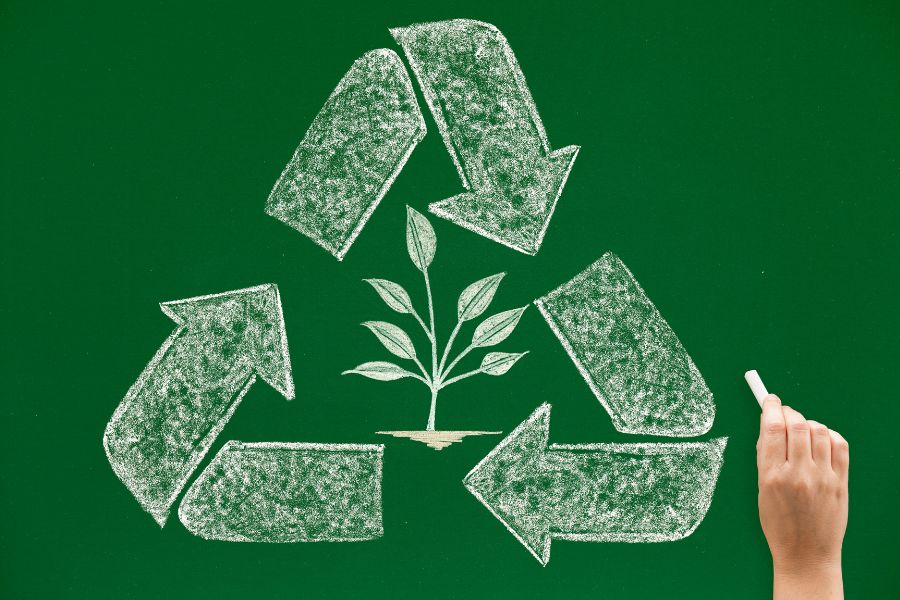You are no doubt familiar with the choice between carrots and sticks (remember, these are metaphors, except for horses). In other words, when trying to bring about or prevent a particular behavior we can choose between rewards or penalties. Both approaches can work, although usually imperfectly, even when the potential reward or punishment is substantial (as both psychologists and parents will attest).
Is there a third way? How about, “let’s all chip in, share the cost and the responsibility, and work together to make things better.” That may sound like a fairytale but when looking for ways to reduce certain industries’ environmental impacts, it’s nonfiction, and it’s happening now. We’re talking about Extended Producer Responsibility (EPR) programs—a sadly dull name for an important idea. Perhaps because the name lacks pizzazz there is a lack of awareness about EPR. We think it’s time to change that.
Extended Producer Responsibility programs distribute the responsibility for what happens to a product when it comes to the end of its “useful life” (in quotes because what is no longer useful to one person may still be quite serviceable to another). EPR strategies usually focus on product manufacturers/producers but may include other entities involved in getting the product into consumers’ hands. These programs shift the cost (some or all) of managing what happens after a product has been used away from the public and local governments, who rely on trash collection, to product producers.
EPR programs help prices to reflect end-to-end costs
Based on the principle of “polluter pays,” producers become responsible for recycling and safely disposing of the waste their products generate after they have been used. This encourages manufacturers to consider reusability and recyclability from the start of the product design process and at every stage of a product’s lifecycle. This, in turn, allows product prices to reflect the cost of processing and disposing of the product at the end of its useful life, and puts that responsibility on the producer or brand owner who makes those design decisions. It also helps consumers to better understand a product’s environmental impact.
EPR programs require manufacturers to take back, recycle, and/or responsibly dispose of certain products. According to an article highlighted in Science Direct, more than 70 such laws have been passed in 32 U.S. states, covering ten consumer product categories, including car batteries and mobile phones, paint and pesticide containers, and fluorescent lamps. EPR policies and programs have been established in Europe, Canada, Japan, and South Korea for a wide range of products. In Europe, policies making manufacturers responsible were implemented after voluntary take-back programs failed. All EU Member States have EPR programs for packaging, batteries, end-of-life vehicles, and electrical and electronic equipment). In less developed countries EPR is still in the early stages.
This concept is familiar to residents of a minority of U.S. states. For many years (decades, in a few cases) some states have required retailers to charge consumers a “deposit” (a few cents) on beverage containers, to repay the retailer for the deposit it had to pay to the beverage distributor. If a consumer returns the container to the retailer, the retailer can return it to the distributor so the consumer’s deposit is refunded. Most people don’t return their own bottles and cans, but anyone can collect them and turn them in for cash. It’s not an easy way to make money but if you do it in bulk, it does create an incentive to recycle.
Packaging – low-hanging fruit for recycling?
The Wall Street Journal reports that, in the U.S., new EPR laws (some still in development) target packaging waste and recycling. Four states have launched programs for packaging, according to the Recycling Partnership. California’s regulator CalRecycle will start receiving money from fees collected through its EPR program in the next few years, and more than a dozen other states are expected to consider similar policies this year.
According to the Sustainable Packaging Coalition, most EPR programs for packaging either encourage or require companies that make packaging products to join a collective producer responsibility organization (PRO), although many allow such companies to act individually. The PRO develops and manages a producer responsibility program. In some states, these components are referred to as a stewardship organization and stewardship plan. PROs are typically required to be nonprofit organizations, and a common approach is to allow for multiple PROs to operate within a single region’s EPR program.
The financial structures involved may vary, but in most EPR programs producers pay fees to the PRO. The PRO then distributes the funds to cover the costs required by program legislation. Costs typically include end-of-life management for covered products (collecting, sorting, and processing). Products covered by the PRO are defined in terms of the specific items or materials that must be managed within the program.
The U.S. is not the only country where EPRs are taking hold. In fact, EPR regulations for packaging are well-established in other regions of the world, particularly in the European Union and Canada.
These are all steps in the right direction, but, after glass bottles and aluminum cans, packaging waste is almost low-hanging fruit in terms of recycling. Others types of waste that are big contributors to the world’s waste problems are more challenging. Pharmaceuticals is one example where EPR strategies are needed—although most countries have laws regulating safe disposal of medical waste in hospitals and doctors’ offices they may not have ways for consumers to return unused medications to pharmacies.
The apparel industry has a waste problem
Not to spoil the fun of buying a new shirt or pair of pants, but our clothes (many of which, if we’re honest, we rarely wear) create a lot of pollution and a big recycling problem. According to the U.N., 85 percent of textiles end up in landfills. In an article titled Fast Fashion and Sustainability—It’s Not a Good Look, American Century Investments notes that producing apparel is “environmentally destructive, contributing to pollution, waste, greenhouse gas production and excessive water consumption.” Can EPR help address this one?
The Wall Street Journal article cited above says that for more than a decade, France (yes, the “grande dame” of fashion) has had an EPR program that charges clothes sellers a fee to fund programs to manage the industry’s waste. However, only 34 percent of textiles in France were collected for recovery in 2021, suggesting that more funding and infrastructure is needed. EU rules require member states to separate out textile waste from other trash by 2025 and the European Commission is now preparing a broad EPR proposal.
A lot more could be reduced, reused, and recycled
In our article on building a circular economy, we quoted the CEO of the Ellen MacArthur Foundation as saying, “recycling alone will not save us.” Still, not making an effort to design products in a way that increases recyclability is, in our view, irresponsible. EPR programs provide incentives to step up this effort. California has EPR programs that cover the following:
- Paint: The Paint Stewardship Program ensures that leftover paint is properly managed in a manner that is sustainably funded.
- Carpet: The Carpet Stewardship Program ensures that discarded carpet becomes a resource for new products.
- Mattresses: The Mattress Stewardship Program aims to reduce illegal dumping, increase recycling, and substantially reduce local government costs for the end-of-use management of used mattresses.
- Pharmaceuticals and Sharps: The Pharmaceutical and Sharps Waste Stewardship Program requires safe and convenient disposal options for pharmaceutical drug and home-generated sharps (think “needles”) waste.
- Mercury Thermostats: The Mercury Thermostat Collection Act of 2008 provides for producer responsibility of mercury thermostats.
- Pesticide Containers: Food and Agricultural Code Section 12841.4, covering pesticide container recycling, requires first sellers using certain pesticide containers to participate in a certified high-density polyethylene (HDPE) pesticide container recycling program.
We expect to see other states head in this direction if they haven’t already.
Understanding a company’s efforts to make its products recyclable and its participation in EPRs can help investors and analysts to make more informed decisions about its sustainability. Contact OWL ESG to learn how our timely, transparent data sets can help you with this analysis.




